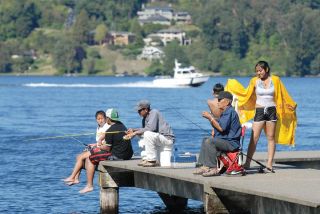Forecast is less than half of preseason for fishes’ return, Cutthroat trout is OK
By J. Jacob Edel
Mercer Island Reporter
It doesn’t look like there will be a sockeye season this summer. Sockeye salmon returns to Lake Washington are much lower than expected this year. Cutthroat trout, however, are abundant.
As of the end of July, only 60,117 sockeye were counted while passing through the Ballard Locks. That number is less than half of the preseason forecast for the 2007 sockeye return.
Roger Urbaniak, an Island resident and vice president of the Lake Washington chapter of Puget Sound Anglers, said he doesn’t expect the sockeye season to happen this year with such a low return. However, Urbaniak is not discouraged. He said there are many small mouth bass — enough to encourage small tournaments that attract anglers from across the country — over three pounds in Lake Washington. He also said there are about 10 million perch in the lake. And cutthroat trout are out there in the deep waters as well.
Without a sockeye season, there is still the opportunity to fish for cutthroat trout in Lake Washington. Cutthroat are apparently doing well in the lake.
“We consider cutthroat a pest because they’re increasing in number and they are the primary predator of young salmon,” Urbaniak said.
Cutthroat trout are believed to be native to Lake Washington and are born in local streams, such as the Juanita, Thornton, McAleer, Coal, May and waters in the Mercer Slough. They also hatch in the Sammamish and Cedar rivers and their tributaries. Cutthroat grow rapidly, feeding on the lake’s huge population of longfin smelt, as well as other small fish such as sticklebacks and salmon fry, the young hatchlings.
While cutthroat fisheries remain strong, bull trout populations are protected under the endangered species act, and salmon populations remain threatened as well. However, scientists say cutthroat have curiously become more abundant over the past 10 years. Biologists from the University of Washington are studying the cutthroat populations, yet the exact reasons for their success remain unknown.
Reasons for the low production rate for Lake Washington fish are not yet fully understood. Whatever the cause, the low production rate means that the sockeye are delicately balanced between success and failure. Some of the problems are due to freshwater and ocean survival constraints and an increased frequency in damaging winter floods.
In addition to teaching fishing techniques, the Lake Washington chapter of Puget Sound Anglers actively works to promote and enhance local fisheries. Urbaniak said the group helps hatcheries raise sockeye that will return to the lake. The group incubates coho and sockeye salmon on the lakes shores as well. Over 200,000 coho have been released in Lake Washington incubators with eggs from the Issaquah hatchery, Urbaniak said.
The most recent published count of sockeye passing through the Ballard Locks on July 31 was 60,117. State and tribal agencies estimated estimated 125,000 sockeye would return this summer, based on the number of hatchlings from spawners in 2002 and 2003. In order to open sockeye fishing, the State Department of Fish and Wildlife needs to count over 350,000 fish. Although some sockeye are observed at the locks as early as mid-May, the count does not officially begin until June 12. Members of the Muckleshoot Tribe and the state fish and wildlife department conducted the formal sockeye count from June 12 until the end of July.
Last year, an unprecedented 458,005 sockeye passed through the locks and the season lasted over two weeks. At the end of July 2005 the numbers were low, similar to this year, with 74,821 sockeye going through the locks. In 2004 a return of 376,659 was counted. If the return is greater than 350,000, the excess is made available to sport and tribal fisheries.
Sockeye are not native to Mercer Island’s surrounding waters. They were first introduced into the Lake Washington watershed in 1935. The first documented adult returns to Lake Washington were in 1940 when 9,099 sockeye were counted at the Washington Department of Fisheries hatchery on Issaquah Creek. Today, the Cedar River — which enters the Lake Washington near Boeing Field — provides the spawning grounds for approximately 90 percent of the lake’s spawning run.
Coho salmon fishing will open on Sept. 16. It will be limited to parts of the lake north of the 520 bridge. According to Steve Foley, an employee with the State Fish and Wildlife Department, the south lake closure helps wild coho return to the Cedar River to spawn. The north lake is open because most salmon heading that way from the Ballard locks are from the Issaquah hatchery on their spawning journey back through Lake Sammamish.
Fish study
On most of the Island’s landings, anglers may have noticed signs of a current study requesting their help.
State and federal fishing organizations are asking local anglers to record their opinions and experiences in the Washington Saltwater Anglers Survey, developed by the Wild Fish Conservancy in collaboration with the U.S. Fish and Wildlife Service. The survey is taking place through next summer. Signs have been posted around the Island’s landings for a couple months now.
According to Ramon Vanden Brulle, an analyst with Washington Trout, the study is looking at the decline of bull trout stocks in Lake Washington. Bull trout and Dolly Varden, a similar species, are listed as “threatened” under the Endangered Species Act. The Wild Fish Conservancy is trying to determine if anglers are accidentally keeping bull trouts because they can’t differentiate between them and other fish or if they are actually fishing for them, Brulle said.
The survey has 80 questions but many do not pertain to some anglers, depending on the type of fishing they do.
Collecting information from local anglers is critical for sustaining fish populations and fishing opportunities, the Wild Fish Conservancy Web site says.
To take the Saltwater Anglers Survey, click on the link at www.washingtontrout.org.


